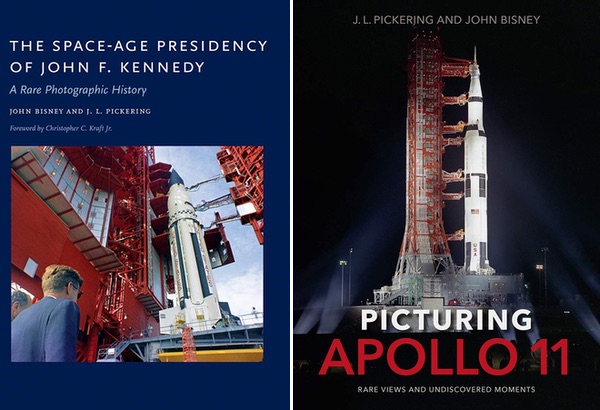Reviews: Photography and Apolloby Jeff Foust
|
| The authors perused the NASA archives for photos for the book as well as from other sources, from the Kennedy presidential library to those taken by a French photographer. |
Two books by the same authors take similar, but complementary, approaches to offering photographic histories of Apollo. The Space-Age Presidency of John F. Kennedy, by John Bisney and J. L. Pickering, review the early spaceflight era, including planning for Apollo, through the lens of the Kennedy presidency. Picturing Apollo 11 by J. L. Pickering and John Bisney focus on the Apollo 11 mission itself, from the training and pre-launch preparations through the mission and beyond.
The Space-Age Presidency of John F. Kennedy recaptures the space-related events of the Kennedy Administration throughout his time in office. These range from pictures of him watching on television Alan Shepard’s Mercury flight through his visit to the aerospace medical facilities at Brooks Air Force Base in San Antonio, Texas, on November 21, 1963, the day before his assassination. In between are copious images of White House visits by Mercury astronauts and trips by Kennedy to Cape Canaveral, Huntsville, Houston, and other locations associated with the early space program.
Bisney and Pickering write in the introduction that they perused archives at Kennedy Presidential Library and Museum to find plenty of “unpublished or rarely seen” photos about Kennedy various space-related events. That results in plenty of new images about familiar events, from Kennedy’s 1962 speech at Rice University—part of a trip that also included stops in Huntsville, Cape Canaveral, and the McDonnell plant in St. Louis—as well as lesser-known events, like a trip to New Mexico and Nevada in 1962 to review efforts to develop nuclear engines for space applications.
Likewise, Pickering and Bisney dive into archives for Picturing Apollo 11 to find new views of one of the most chronicled voyages of exploration ever. They rely on not just NASA photos but other sources as well, such as the archive of the late French photographer Jacques Tiziou and a collection the authors acquired from a retired employee of a contractor who handled photography at the Kennedy Space Center.
| “I have also become aware that photos I consider common are not always viewed that way by others,” Pickering notes. “This especially applies to younger people, who may be seeing the ‘greatest space hits’ for the first time.” |
Like the Kennedy book, this goes in chronological order, with a little background about Neil Armstrong, Buzz Aldrin, and Mike Collins, followed by pre-launch preparations, the mission itself, and the post-mission activities, including following the astronauts in the commemorations of the mission for decades to come. The book, though, also includes images of the broader scene, particularly at the Cape, during the time of the mission: people checking out a lunar module model at the KSC visitor center, crowds lined up along the coast to watch the launch, images of long-gone hotels and restaurants that captured the space theme of the era.
Pickering, in the introduction to Picturing Apollo 11, noted the challenge of finding new views of familiar events. Some, of course, are familiar, or offer different angles on familiar events. “I have also become aware that photos I consider common are not always viewed that way by others,” he notes. “This especially applies to younger people, who may be seeing the ‘greatest space hits’ for the first time.”
Both books, though, do offer a lot of images that have not been seen, or at least not seen often, sometimes to the surprise of the authors. “How is it possible that no one has done this book before us during the last fifty-five years?” Bisney asks in the introduction to The Space-Age Presidency of John F. Kennedy. One answer, of course, is the sheer volume of such images that were locked away in archives for decades and difficult to find. Similarly, the filmmakers of Apollo 11 stumbled upon a treasure trove of wide-format film that had been locked away for decades and became the foundation of their new documentary (see “Review: Apollo 11”, The Space Review, March 4, 2019).
Both books take similar approaches such a chronological organization and only brief passages of text (but with, at times, extensive captions for individual photos.) Neither book does much to change existing knowledge about Apollo 11, or the overall Apollo program, but even for those well-versed in that history, the books provide different, refreshing views of those familiar events.
Note: we are temporarily moderating all comments subcommitted to deal with a surge in spam.
